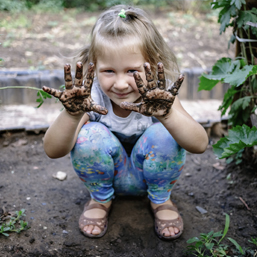
Spring has sprung, and getting your hands dirty is a great way to teach your young children all kinds of gardening skills while having fun!
If your thumb is any color but green, no need to worry! Planting and gardening doesn’t have to be complicated. There are several easy projects that you and your toddler or preschooler can enjoy together.
Kristen Busse, greenhouse manager of Green Gate Garden Centres, has all kinds of wonderful ways to learn how to cultivate food, fun and facts with your little horticulturist.
Setting up
Many children will get more enjoyment out of planning and setting up the garden than planting or working on the daily maintenance! Consider some gardening-adjacent projects that can be started and finished in a day or two to get your kids interested.
Some great fun projects for young children include:
Sustenance
If you are hoping to broaden your child’s skillset, experience and diet, planting vegetables and edible flowers is a great way to do it! “Many vegetable scraps will re-grow by putting them into a glass of water – avocado, green onions, carrots, romaine hearts, celery, beets, and pineapple,” says Kristen. “You could also plant peanuts or pieces of potato or individual garlic cloves.” Kristen also suggests that there are many different types of squash and gourds that grow into unusual shapes that children love, although these don’t always make it to full size before the fall frost. (Start early!) Beans, peas, lettuce or any other leafy green, radish, herbs and sunflowers all grow easily from seed. Carrots also grow easily from seed, although they take a long time to germinate.
“What I think parents need to be aware of when it comes to gardening with their kids is to think about how quickly they want to see results,” says Kristen. “There are so many options for seeds that you can choose a short germination period for almost instant gratification, or a longer germination period.” Peppers, tomatoes, eggplant, and other long-season crops need to be started inside and then planted outside. Kristen cautions that these are easy to grow, but the kids will need to wait a long time to taste anything.
“You could also plant some edible flower types for a completely different idea – marigolds, pansies, violas, nasturtiums, or bachelor buttons,” she adds.
Space
You may be thinking, “that’s all well and good, but I don’t have a large backyard with unlimited space to grow these things in!”
No worries, we’ve got you covered.
“Busy parents with limited space can grow just about anything in a container,” says Kristen. “Many vegetables have ‘container-friendly’ versions that don’t grow as large as the traditional type.”
Another good idea is to buy seedlings as small starter plants, so you don’t have to wait for the seeds to germinate. If you’d rather plant seeds, many vegetable seeds are available in seed tape so they’re perfectly spaced.
There are also seeding kits available which include growing pellets, a tray and a lid to make the growing space self-contained.
You may also wish to consider planting bulbs. “Planting bulbs is really easy and there are so many different sizes of bulbs that parents can choose bigger ones or smaller ones depending on the age of their child,” adds Kristen. Unlike tiny seeds, bulbs are easily managed even by small hands and you won’t end up with an accidentally dropped packet ruining your planting plans!
Skills
Children can learn so many things while gardening. An appreciation of nature, weather patterns, facts about birds and insects, the satisfaction that comes from growing your own food, being outdoors and moving their bodies are all valuable experiences for aspiring agriculturists.
“There are so many physical aspects to gardening, from digging to raking to planting to watering to weeding,” says Kristen. “Seed and bulb planting works on fine motor skills and dexterity. There are spatial skills involved with spacing the plants and seeds, and arrangement of plants and seeds in a container or flower bed.” Gardening also teaches math and science skills such as counting, measuring, comparing, and analyzing. Then there’s the sensory experience of touching dirt and plants, smelling the plants, hearing the sounds of birds and insects and tasting what you’ve grown. Children also learn a deep sense of responsibility, as the plants need to be watered, fed, weeded, and taken care of.
“There’s self-confidence in planting and watching something grow,” adds Kristen. She says the most important things for parents of young children to keep in mind while planting and gardening is that it does take time – but everything worthwhile in life does!
Stacie is the associate editor of Calgary's Child Magazine.
See our related stories:
Calgary’s Child Magazine © 2024 Calgary’s Child